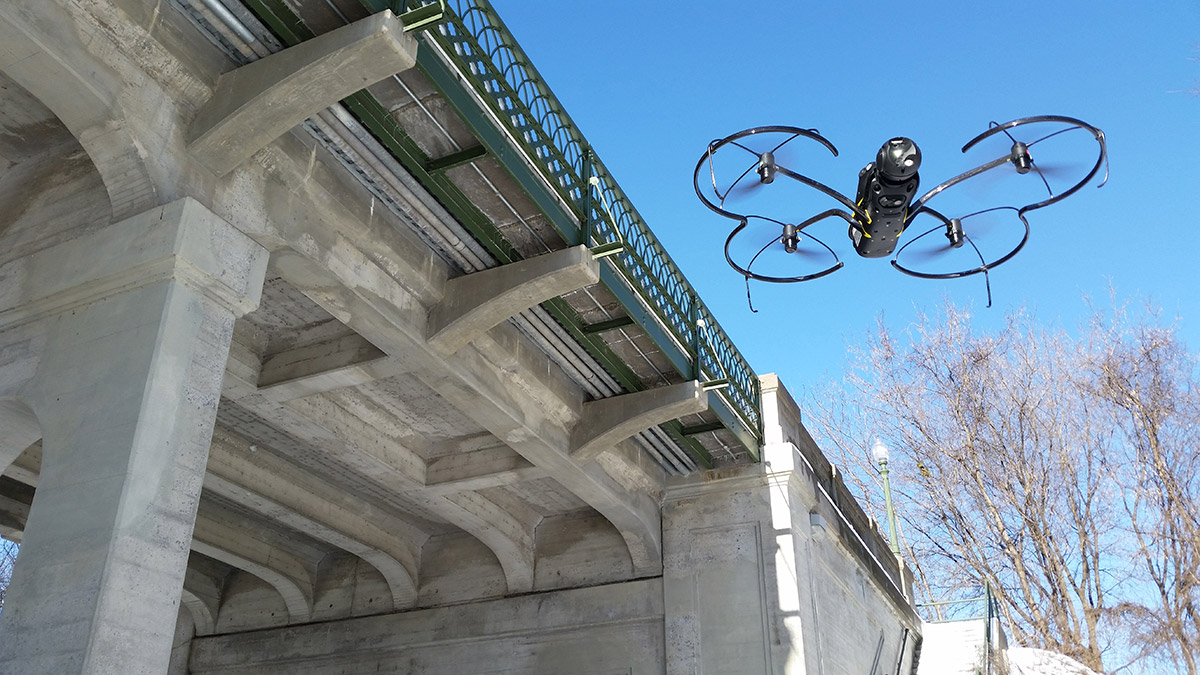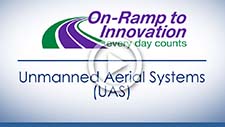August 8, 2019
Innovation of the Month:
Unmanned Aerial Systems
Last week, we introduced unmanned aerial systems (UAS) and discussed how they are valuable tools in design, construction, and operations. This week we focus on UAS as a structural inspection tool.
Structural inspection includes bridges, high mast lights, confined spaces, retaining walls, and tunnels. UAS gives inspectors a better view of hard to see elements and provide a unique bird's-eye view.
Current bridge inspection methods rely on visual and hands-on evaluation techniques performed by inspectors. Inspectors must be able to see all bridge elements, sometimes requiring several types of access equipment. UAS help inspectors quickly and safely see bridge components that are difficult to reach and provide useful information that can help inspectors determine whether additional, more detailed inspection is needed.
By minimizing the need for large equipment, UAS improve inspection safety, reduce lane closures, and lower overall inspection time and costs. The traveling public also benefits from a reduced need for temporary work zones.

Since adopting UAS, the Minnesota Department of Transportation (MnDOT) reports average cost savings of 40 percent over traditional inspection methods. The UAS program has seen improved data quality from inspections, especially in difficult-to-access bridge elements such as confined spaces, high wall abutments, steep slopes, and piers under traffic. Before UAS, MnDOT used traditional access methods (under-bridge inspection vehicles, ladders, lifts, rope access) that were costly and limited by lane closure availability. Since adopting UAS, MnDOT delivers infrared and 3D modeling detail of bridges, gathers topographic mapping detail, and can identify concrete delamination.
For more information, view the UAS innovation spotlight video. To learn how you can use UAS to improve your agency's structural inspection program, contact James Gray with the FHWA Office of Infrastructure or John Haynes of the FHWA Utah Division.
Weather Responsive Management Strategies (WRMS) Resource Toolkit Now Available
The Weather Responsive Management Strategies (WRMS) Resource Toolkit provides a range of products and resources to support program implementation and adoption. WRMS help agencies execute traffic and maintenance management strategies during inclement weather, improve safety and reliability, and minimize environmental impacts of weather on the transportation system.
Visit the toolkit for a variety of resources, including:
- Fact Sheets, Case Studies, and Guidelines
- Webinars and live events
- Reports, Articles, and Presentations
- Videos
Bookmark the WRMS Resource Toolkit, and check back often for updates. To learn more about WRMS, contact Roemer Alfelor with the FHWA Office of Operations.
Caltrans Incorporates Data-Driven Safety Analysis
The California Department of Transportation (Caltrans) is one of many agencies to implement data-driven safety analysis (DDSA) techniques in their projects.
Caltrans developed guidance for incorporating quantitative safety analysis into its project development process. The guidance is based on predictive analysis methods from the American Association of State Highway and Transportation Officials Highway Safety Manual (HSM). Predictive analysis lets agencies determine the future safety impacts of multiple design alternatives side by side; justify design exceptions; and incorporate performance-based practical design principles.
Caltrans also launched a project that will allow it and its local partners to perform even more robust safety analysis. The effort will create data definitions, quality assurance procedures, and performance measures so local agencies can collect data on model inventory of roadway elements—information that is critical to safety management. To learn more about these efforts, contact Thomas Schriber with Caltrans.
To learn how your state can incorporate DDSA to analyze crash and roadway data, please visit the EDC DDSA webpage. You can also contact Jerry Roche with the FHWA Office of Safety or John McFadden with the FHWA Resource Center.
About EDC
Every Day Counts, a State-based program of the Federal Highway Administration’s Center for Accelerating Innovation, works with State, local, and private sector partners to encourage the adoption of proven technologies and innovations to shorten and enhance project delivery.



